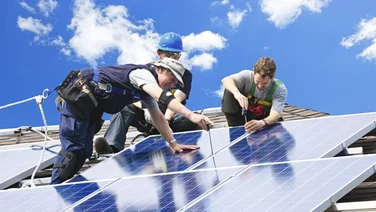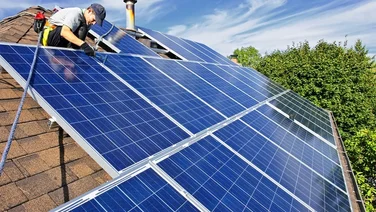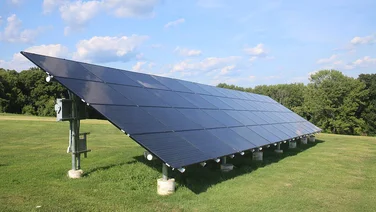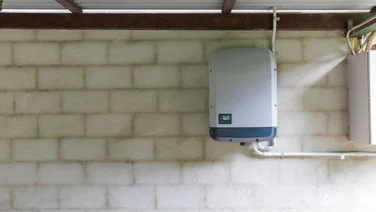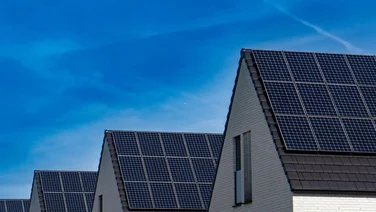- Contrary to popular belief, the UK is actually an ideal place for solar panels
- Panels can be used to heat a house in several different ways
- Payback won’t usually be quick, if at all

Solar panels work by reducing your reliance on the grid, but they can also lower your carbon footprint and save you money on your energy bills.
In this article, we’ll explore the various ways you can heat your house with solar panels and how much it’ll roughly cost.
If you want to know how much it’ll cost you to get solar panels installed, simply enter a few details in our short form. Our expert installers make it easy by getting back to you directly with bespoke quotes.
Where do you want to install solar panels?
Get startedIs it possible to heat your house with solar panels?
Yes, it is possible to heat your house with solar panels in the UK.
Contrary to what many people may think, the UK is actually an ideal place for solar panels – in fact, 1.2 million UK homes have solar panels. In the UK, the summer months offer the perfect temperatures for solar panels to be highly efficient. They can still produce a decent amount of electricity the rest of the year when it’s colder and cloudier too.
There are different ways you can heat your home with solar panels, and in this article, we’ve shared some of the options to help you decide what might be best for you.
Heating your home with solar thermal panels
Solar thermal panels are different to solar photovoltaic (PV) panels – the latter is more popular and better known, however solar thermal panels have some great benefits. They are not only cheaper than PV panels, but more efficient too.
This is because solar thermal panels don’t turn sunlight into power like PV panels, instead, they turn it into heat. As there is no process of transformation into electricity, they are more efficient in their use, at around 70% whilst PV panels are around 15-20%.
They are specifically designed for heating water and use solar collectors to capture sunlight. The solar collectors are connected to a system that circulates a heat transfer fluid, typically a mixture of water and antifreeze.
As the fluid flows through the collectors, it absorbs the heat from the sun and becomes hot.
The heated fluid is then transferred to a water cylinder. This retains the heat, allowing it to be used later when the heating system demands it. The hot water can be distributed through radiators or underfloor heating systems to warm your home or used for bathing or washing dishes.
Another way to heat a house with solar is with hybrid solar panels, which produce both heat an electricity.
How much does this cost?
Solar thermal panels typically average £4,000 for a three-bedroom house, plus installation fees. However, most properties will also need to purchase a larger water cylinder as it’ll need to house the heat exchanger system and be able to store enough hot water to be used on days when there’s less sun.
A typical household with a gas boiler will save around £75 a year on bills, so you won’t break even with solar thermal panels, but you won’t break even on a gas boiler either. At least using solar means you’ll be lowering your carbon footprint.
Want to find out more? Check out our page: Are Solar Thermal Panels Worth It In The UK?
Where do you want to install solar panels?
Get startedHow big is your solar panel system, and how roughly much did it cost?
“We have a 5.76 kilowatt (kW) system, comprising of 16 360 watt (W) fully black Canadian solar panels. They’re connected to a Solis 5G 5.0 kW dual tracker inverter, with direct current (DC) isolation […].“We paid just under £5,000 for the whole system, and £750 for an electric car charging port.”
Do your solar panels generate enough power to cover all your electricity needs?
“I would say that they cover half of our electricity needs, or up to two thirds. Obviously when there is more sun, we are better off.“We have a smart meter, and I see it set to zero a lot of the time.”
Are you receiving money via the Smart Export Guarantee?
“We are with Octopus Energy, and I think we get 9p per kilowatt hour. We signed up for the Smart Export Guarantee when we signed up with Octopus.”
Melissa lives in the East Midlands, and has owned solar panels since July 2022.
Powering a heat pump with solar panels
A heat pump extracts heat from the air, ground, or water and transfers it to your home at a higher temperature. You can easily combine your heat pump with solar panels.
However, it’s likely you’ll still need to use electricity from the grid during the winter and on the days that aren’t sunny enough to provide sufficient power. It’s very difficult to power a heat pump entirely with solar panels, as you will need a very large solar PV system which will consequently be oversized during the winter.
You can find out more about how solar panels work in winter by visiting our page.
The answer to the question: how many solar panels to run a heat pump? is that you would 20 solar panels for a 5-kilowatt heat pump to heat a three-bedroom house. This is double the number of panels usually needed for standard electricity consumption! Having a solar battery to store power will help, but it still won’t make you fully independent from the grid.
How much does this cost?
Air source heat pumps cost £10,000, on average, whilst a ground source heat pump averages at £16,500. However, if you own a property in England or Wales and are looking to replace a fossil fuel heating system, you could be eligible to get a £7,500 grant through the government’s Boiler Upgrade Scheme.
A 4.2-kilowatt solar panel system – the average for a three to four-bedroom home – will cost you £8,431, bringing the total cost to £10,931 (if you receive the government grant and go for an air source pump).
If you wanted a solar panel system that could power your heat pump fully in the summer, you’d need 20 panels for a three-bedroom property, which would double the cost to £14,052 (plus £2,500 for the pump). This would bring the total to around £16,552.
Although heat pumps are more efficient, they tend to have similar running costs to a gas boiler, meaning energy bills won’t be any cheaper. This means you won’t break even on this option, but you will be combating climate change with a green energy option.

Powering a hot water cylinder with solar panels
Powering a hot water cylinder is usually relatively easy to set up. The panels are used to generate electricity, which is sent through a metal coil within the hot water cylinder.
The coil directly heats the water in the cylinder which can stay hot for one to two days. Alongside this, the cylinder usually has a secondary coil that can receive heat input from either a gas, oil or electric boiler, whilst an immersion heater acts as a backup in case this were to fail.
How much does this cost?
Depending on if they’re vented or unvented, hot water cylinders tend to cost anywhere from £250-£2,000, plus installation fees. Therefore the solar panel system will be the larger expense in this instance. Using the three-bedroom house example used previously, this would cost around £7,026, plus around £500 for the cylinder, meaning a total of about £7,526.
In the summer months, it’s possible to heat your water solely using solar power (of course this is somewhat dependent on the number of people in your household and the average water use). However, in winter months you’re likely to need backup from another source which will increase your bills.
The estimated annual gas bill for a medium three-bedroom home is £1,345.96. As a cautious estimate, let’s say your solar panels cover your hot water needs completely for five months, your average annual gas bill would go down to £785.12. This equates to a payback period of 13.4 years, if you spend a total of £7,526 on the panels and cylinder.
Powering infrared panels with solar panels
Instead of directly heating the air in a room, infrared panels heat the walls, ceiling and floor evenly which absorbs the heat and gently re-emits the heat back into the room. This is more efficient than conventional radiators which waste energy by heating large volumes of air.
To power infrared panels with solar panels, an inverter is required to convert the direct current (DC) generated by the solar panels into alternating current (AC) electricity, which is compatible with your home’s electrical system and can power the infrared panels.
How much does this cost?
Infrared panels cost an average of £7,000 to heat a three-bedroom home. The cost will increase if you want more aesthetically pleasing panels that double up as a mirror or a painting. You can knock off £1,500 if you get ceiling-mounted panels rather than wall-mounted panels. You also have to factor in the solar panel system itself – we’ll use our average cost for a three-bedroom home of £7,026.
The average amount for running infrared panels to heat a three-bedroom home totals £742 per year, whereas heating a similar home with an electric combi boiler would cost £2,040. Bills are definitely lower, but the payback period for infrared panels powered by solar would still be around 20 years.
What’s the best way to heat your home with solar panels?
Ben Price, the co-founder of Heatable, explains, “The cost to run a heating appliance using solar panels depends on a variety of factors including the size and efficiency of the appliance, the size and efficiency of the solar panel system, local electricity rates, amount of sunlight available in your area and user behaviour.”
The best way to find out how to heat your home with solar panels is to consult a professional installer who can provide more specific guidance on your individual needs. Options that pay back quickly are hard to find, but if your main goal is to lower your carbon emissions, then all of the options in this article are worth considering.
Next steps
Solar panels definitely can heat a house in the UK, and there are different options to research and consider. The first step is to determine how much it’ll cost you to get solar panels installed in your home. To compare solar panel prices simply enter a few details, and several quotes relevant to your needs will be sent to you from our trusted installers.

